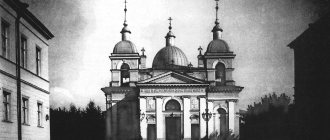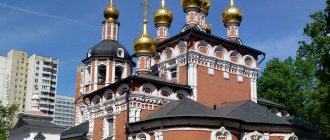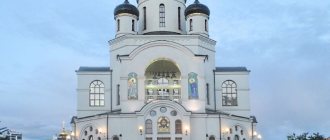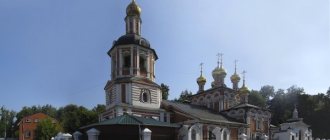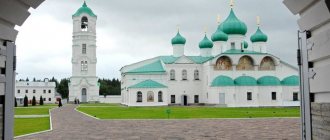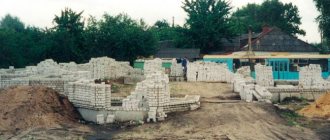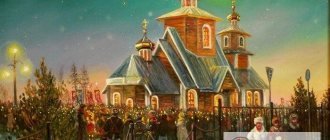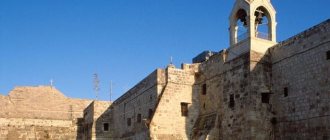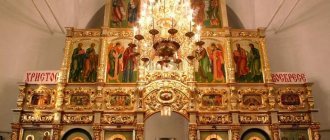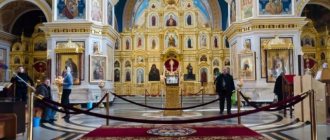Many urban legends are associated with the settlement on the left bank of the Voronezh River, which is known as the settlement of Pridacha. In the 16th century, land plots in this area were given to those who were ready to defend the city borders from Tatar raids. A wooden church was erected on the territory of the settlement. Historians believe that it appeared around 1680. Today there is a dilapidated Church of the Nativity of Christ in Voronezh, which is a significant architectural landmark. It is noteworthy that these territories became part of the city only in 1930.
Residents of all nearby villages were assigned to the active church. The wooden building was repaired twice. In 1785, the townspeople built the first stone church in its place. But it turned out to be small in capacity, so large-scale construction of a new religious building made of brick began. The Church of the Nativity of Christ on Pridacha appeared on the Left Bank in 1856.
Church of the Nativity on Pridacha (Voronezh), photo 2021
Features of the structure
The basis of the Nativity Church in Voronezh is the most ancient type of Orthodox church - the “ship”. It is characterized by the fact that all parts of the church are located on the same line. This structure had a deep biblical meaning - the temple, like a ship, protected believers from the disastrous, sinful waves of the real world and directed them to the Kingdom of God.
The architectural forms of the religious building bore the features of classicism, which was the most popular in the 18th century. The main differences in the architectural style were considered:
- Strict forms
- Clear spatial solution
- Laconic finish
- Muted colors
Church of the Nativity, archival photo
Symmetry was a prerequisite for classicism; restrained decor in the form of bas-reliefs, floral ornaments or arched openings was allowed. According to the Insurance Inventory of 1916, the length of the church (temple and bell tower) was 53 m, width - 18 m, and height - 10.5 m. The height of the three-tier bell tower to the cornice was 30 m. The church was decorated with a single dome with 12 windows. Today, the beauty of the Church of the Nativity can only be judged by a few illustrations from 18th-century magazines. Based on them, sketches were created for the future restoration of the church.
After the construction of the church was completed, it became multi-altar. Side chapels were built next to the main altar and in the refectory. They were consecrated with the names of revered Saints. The Church of the Nativity on Pridacha also differed from other churches in that it owned a large plot of land. She also operated a stone shop and two forges. The income received ensured the maintenance of the clergy. At the end of the 19th century, a Sunday school was built next to the church.
There was a cemetery next to the church, which was called Pridachenskoye. Even after the closure of the temple during the Soviet period, it continued to operate. The most famous burial was the grave of St. Theoktista of Voronezh, who labored in Voronezh in the 20-30s of the twentieth century. At first she lived in one of the cells of the local monastery, and after its closure she wandered wherever she had to. Eyewitnesses claim that Theoktista had the gift of foresight and could heal with prayer, so many townspeople turned to her for advice. The graveyard was destroyed in 1960. A design institute appeared in its place. But the believers, who honored the memory of Saint Theoktista, managed to transfer her remains to the Left Bank cemetery. Currently, several crypts and a gravestone from the burial of honorary citizen of Voronezh Anna Ankindinova have been preserved on the site of the cemetery.
Activities of the parish
Currently, services are held in the church, a detailed schedule of which can be found on the church website. A collection of donations is also open for the ongoing process of revival of the temple.
Shrines
It is known that one of the shrines of the temple are the relics of St. John Chrysostom, to whom one of the chapels of the temple was once dedicated. Quite recently, a piece of the relics of this saint was returned to the Church of the Nativity, which is being restored.
Patronal holidays
The patronal feast day of John Chrysostom is celebrated annually on November 26, on this day all-night liturgies and morning prayers are held at the holy relics of John.
Temple in Soviet times
Like all other churches in Voronezh, the Church of the Nativity remained active for several years after the revolution. Difficult times came in 1922, when local authorities decided to seize all valuables from the church. In 1930, the Church of the Nativity in Voronezh was closed. But officially the services were stopped according to the decision of the regional executive committee in 1932. The wording of the document contained a reference to numerous petitions from citizens of the settlement, and even indicated their number - 2215 people.
Initially, it was planned to convert the Nativity Church into a city club-theater, since the Pridacha district became part of the city at that time. In such cultural and educational institutions events were organized that contributed to the communist education of the population. But there is no mention of the work of the club-theater on Pridacha in the press of those years. Either the cultural and educational institution was not in demand, or it was not opened at all, and the authorities’ decision only became a reason for closing the religious institution. Soon, the interior of the ancient unique structure began to be used for industrial purposes.
In the pre-war period, a major renovation was carried out in the ancient building in order to convert the temple into a spinning factory. The events changed the ancient landmark beyond recognition:
- The bell tower and the dome with its supporting pillars have completely disappeared.
- The upper tiers of the church building were destroyed and the vaults of the refectory were demolished.
As a result, the interior turned into a regular work shop. The fact that the building previously had a different purpose was only reminded by the beautiful arches of the windows and some other decorative elements.
The church building was converted for industrial purposes
As you know, during the Great Patriotic War the Nazis were able to occupy only the right bank part of Voronezh. The front line divided the city into two parts. In those harsh times, a repair base was located in an ancient building on the left bank. For some time there was an observation post there. Soldiers who died during hostilities were buried in the working cemetery. In 1943, after the liberation of Voronezh from the Nazis, a dormitory was organized in the former church, where German prisoners of war were accommodated, who were brought in to restore the aircraft plant.
Officially, the building was transferred to the city industrial complex in 1944, and in 1952 the free transfer of ownership of the building took place. In Soviet times, an absolutely tasteless second floor with many small rooms and a triangular pediment was added above the base of the building. This restructuring completely erased the features of ancient architecture. Only the rectangular outlines of the temple part remained recognizable. A high fence was built around the historical building and a significant number of outbuildings were erected. Therefore, only informed people understood the significance of this place in the history of the city. After some time, the dilapidated, unattractive building, which hardly resembled a religious building with a long history, was sold into private ownership.
View of the former temple from Dimitrova Street
For many years, the city leadership did not make any decisions regarding the preservation of the ancient building as a valuable historical landmark. No repair work has been carried out on it for a long time. But the Voronezh diocese did not give up hope for the triumph of reason and constantly negotiated for the return of the ancient church building. Unfortunately, they always ended in vain; the city leadership had no legal grounds to force a private owner to alienate the property.
Saving the Temple
It was clear to both city authorities and commercial structures that the building with a centuries-old history, the oldest surviving building in the left bank of Voronezh, was a significant historical landmark. But at the same time, it never appeared on the list of cultural urban heritage. This means that it could have been demolished like any other dilapidated building. This is what happened in 2015, when a new owner of the site appeared. Dismantling activities led to the demolition of the surviving altar part. Making this fact public caused outrage among the public and the city population, so dismantling activities stopped for some time.
The old building on the Left Bank was destined for demolition
It should be noted that representatives of the construction company who carried out the demolition of the dilapidated building seriously believed that it did not represent any historical value. Their goal was to build a new multi-story building on this site. And this is understandable, because the documents did not indicate that the building made of ordinary red brick was a historical temple building. In addition, there was no negative reaction to the ongoing dismantling activities from the authorities.
The apse part of the Church of the Nativity still managed to be demolished
The opinion of the owners of the land was changed after an ancient fresco was found on the wall of the interior. After such a discovery, a public gathering was organized near the ancient religious building. Besides:
- An appeal to the president and head of the region appeared on the specialized Internet resource change.org with a request to prevent the destruction of the landmark and preserve the unique Nativity Church in Voronezh for future generations.
- An application was sent to the regional Department for the Protection of Cultural Heritage to conduct a historical and cultural examination in order to recognize the object as a historical monument.
Active public action led to the fact that the owners of the site stopped the demolition. The gratuitous transfer of the temple and the land around it to the ownership of the Russian Orthodox Church took place.
Dilapidated, but already belonging to the church, building
A few months later, renovations began in the newly found temple. First of all, they installed the door and filled the large hole in the wall with bricks. An ancient fresco discovered on the wall was examined by a famous Voronezh restorer. The specialist confirmed that the style of the image and the paints used indicate that the image was painted on the wall in the middle of the 19th century. It is quite possible that it appeared during the last renovation of the temple. In addition, the normal condition of the image was confirmed, which guarantees the success of restoration work in the future.
A fragment of an ancient fresco discovered under plaster
Presumably the image occupies the entire wall surface, but so far only two human figures are open to view. Unfortunately, so far it has not been possible to find funds for the global reconstruction of the ancient temple. Therefore, the ancient fresco was closed to visitors to eliminate the risk of accidental damage.
Services are regularly held in the ground floor room. Information about the time of their holding is posted on a piece of paper in front of the entrance to a dilapidated, dilapidated building. But parishioners believe that a little time will pass and the Church of the Nativity will be restored to its former beauty and grandeur.
Banner at the entrance to the temple grounds
Priest Vitaly Kotaev was appointed rector of the temple. He has to simultaneously organize construction work. In the room where services are held, temporary repairs have been completed: the walls are covered with plasterboard and heating is supplied. The icons were printed on a printer, which is acceptable, and inserted into frames. The walls are decorated with them. On the windowsills there are flowers in pots and icons brought by people attending services. This creates a cozy atmosphere.
So far, all restoration work is being carried out at the expense of parishioners and by their efforts. In a short time, 1.5 million rubles were collected. In the future, it is planned to look for sponsors to begin a complete reconstruction of the ancient building. An official website of the temple was created, where on the main page there is a request to all caring people to provide all possible assistance.
It is planned to completely recreate the architectural landmark; sketches have already been developed for this. But the work will be very labor-intensive, because it will be necessary to rebuild the bell tower, erect the dome and restore the altar. The rector dreams that permission will be obtained to build a Sunday school next to the church.
Author: Nina Pavlushina
Description of the architecture
The temple premises are currently still in the process of restoration. At the time of the transfer of the building to the diocese, much was destroyed - the altar was destroyed, the windows were broken, the railings were removed from the staircases. However, at the same time, under the collapsed plaster in different places of the temple, ancient frescoes appeared, which, probably, can be restored.
Interior of the restored part of the temple
In 2021, having begun the renovation of the church, the first thing they did was erect an altar and hold a service, as if consecrating the walls of the temple and encouraging it to new life.
